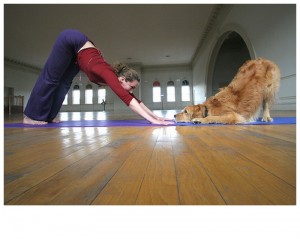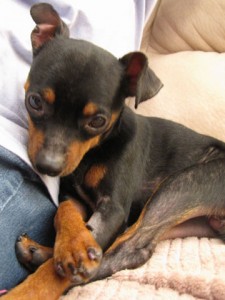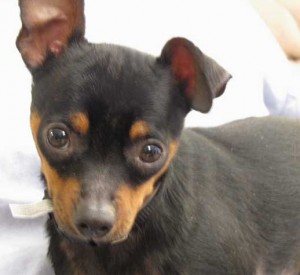
Dog + Yoga = Doga?
Doggie yoga, or doga, is a great way to relax with your dog on a cloudy day. It can bring the tranquility and harmony of yoga to you as well as strengthen the bond between you and your dog.
Humans Do the Strangest Things
When I started practicing yoga at home, my Min Pin/Chihuahua mix was very concerned, especially when I was in corpse pose. I think he was certain that I was ill or injured because when I didn’t respond to his nudges or licks, he sat on my face to guard me. I later learned that some dogs actually participate in their person’s yoga routine. Doga is a great rainy day activity that will engage the body and mind of both you and your dog.
In this extremely cute video, Pancho the Chihuahua mimics his owner’s yoga moves exactly.
How Does My Dog Participate in Doga?
A large part of doga is relaxation for you and the dog. Thus, it is important not to force your dog to do poses it doesn’t feel comfortable doing. That being said, dogs can do several doga poses, and, of course, they get to take part in being petted and attended to by you. In the beginning, you may want to focus on deep breathing and relaxation with your dog. Remember, a large part of doga is strengthening the human-canine bond, and thus, doga should be fun and relaxing for your dog. Min Pins and other small breeds can act as a weight to deepen your stretches. With a larger dog, you may reach over it to extend a stretch or position the dog under your knees in a supine position to relieve pressure on your spine. During the relaxation portion of your practice, add massages for your dog. Leg and joint massages are common among doga practices, and tummy rubs never hurt. Talking to and praising your dog in a soft voice will complement the experience.
See Doga in Action
This12 minute video is an example of a doga class in action. As you will see, the yoga instructor emphasizes allowing the dog to do what it is comfortable doing and not forcing the dog into poses.
If you are interested, doga classes are offered in many major metropolitan areas. When I did a quick internet search for “doga classes,” the results included information about doga classes all over the U.S.
Doga Strengthens the Canine-Human Bond
The biggest benefit of doga, in my opinion, is strengthening the Canine-Human bond. It is well documented that positive feelings, such as love and bonding, release endorphins, which stimulate pleasure centers in the brain. Thus, positive emotions act chemically to make you feel good physically as well as mentally. It is likely that it does the same for your dog.
In addition, when have you ever been with your dog where there wasn’t a chance for laughs? A doga class is no exception and can provide laughs in abundance. Since laughter is the best medicine, you’ll likely get a hefty dose of an all natural remedy for any ailment!
Other Benefits of Doga for Humans
While the humans work toward getting fit, they also socialize their dog and bring the positive energy of the canine-human bond into your yoga practice. An added benefit is that the dog can provide motivation to practice yoga regularly. For example, your dog may start bringing you your yoga mat.
Other Benefits of Doga for Dogs
Dogs need stress relief, too. Dog brains are very similar to human brains, and dogs can suffer from conditions like depression and anxiety just like humans can. Doga can provide one avenue to relieve your dog’s stress, and this will make your dog as happy and healthy as it can be.
In addition, the time you spend with your dog while practicing doga is important to your dog’s health. Dogs have evolved to be near humans, and thus, have a need for bonding with their owner. The time, attention, and tactile stimulation a dog gets from doga is extremely important to form and maintain this bond.
Practice Safe Doga
Be sure to keep your dog’s safety in mind and don’t put your dog in unnatural positions. If you want to balance your dog in some of your poses, make sure your pose is stable and consider having a friend act as a spotter. For example, if you want to balance your dog on your thigh while in a warrior pose, you don’t want your leg to be shaking. Remember that Min Pins have a fine bone structure, which can lead to fractures if your Min Pin falls or is dropped.
What Do You Think?
Have you or someone you know tried doga? What was it like? How did he or she like it? Do you have tips that might be helpful to others attempting doga? Comment below and let us know!



























